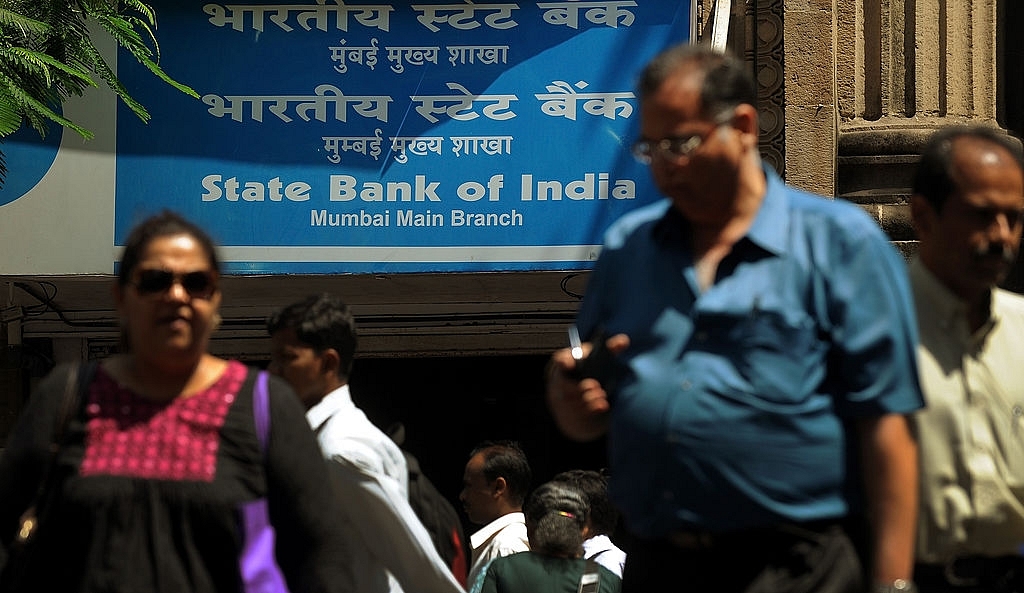Business
SBI Mega-Merger: The Perils Of Creating A Slow-Footed Godzilla
- In an age when nimble is more important than big, the SBI mega merger is not necessarily a cause for celebration.
- Unless the merged entity is able to ruthlessly cut costs, and embraces technology with a vengeance, SBI could just as well become lead ball attached to the taxpayer’s leg.

A State Bank of India branch. (PUNIT PARANJPE/AFP/Getty Images)
The merger of State Bank of India (SBI) and its subsidiary banks (five of them), approved yesterday (15 February) by the Union cabinet, is a double-edged sword, and is probably a decade too late.
On the one hand, it will create a mega bank that will leapfrog into the world’s top 50, with assets of Rs 33.5 lakh crore, 22,500 branches, 58,000 ATMs and 500 million customers, according to a Business Standard calculation.
But size is not sizzle.
The problem is not all “assets” are assets in the commonsense meaning of the term.
A Rs 33.5 lakh crore asset base looks like a huge business, till you learn that around Rs 140,000 crore is in gross bad loans. Maybe SBI should retain one of its five subsidiaries as a bad bank, which can buy out all the bad loans of the group and single-mindedly turn itself into an in-house asset reconstruction company.
Having 22,500-and-odd branches was an asset when the country was underbanked and public sector banks had a monopoly of business. Today, when payments banks can reach the last man through mobile banking and other touch-points, branches can be a liability, except to the extent they are owned real estate. The lakhs of employees needed to man branches are also a partial liability, for public sector banks have some of the worst employee productivity. Imagine the potential for economic damage if these employees decide to go on strike!
Having 58,000 ATMs after the merger means wide reach, but in the age of BHIM – Bharat Interface for Money – and mobile banking, the cost of doling out cash through a physical ATM network can itself become a burden. Digital and e-wallet banking will ultimately replace the need for ATMs, credit cards and even debit cards. The chief executive of NITI Aayog, Amitabh Kant, believes that this can happen in the next few years. Is SBI ready for this brave, digital future with such a huge physical network of costly ATMs and branches?
With 500 million customers, the merged SBI group should ideally be able to ramp up business volumes by mining the data and cross-selling products, but SBI is hardly the most nimble-footed among banks. Now consider another thing: Idea Cellular and Vodafone, two telecom majors now considering a merger, will between them soon have more than 400 million customers, and rising. The SBI’s big customer base will be matched fairly quickly by tech-based payment and other banks. And its new challengers may well be able to do so at lower cost of delivering services.
In an age when nimble is more important than big, the SBI mega merger is not necessarily a cause for celebration. Unless the merged entity is able to ruthlessly cut costs, and embraces technology with a vengeance, SBI could just as well become lead ball attached to the taxpayer’s leg.
It is already too big to fail; a merged SBI can never be allowed to go bust and government will have no option but to keep funding it no matter what the cost to the taxpayer. That is a scarier thought than that SBI will be the next financial Godzilla.
We need to keep our fingers crossed.
Introducing ElectionsHQ + 50 Ground Reports Project
The 2024 elections might seem easy to guess, but there are some important questions that shouldn't be missed.
Do freebies still sway voters? Do people prioritise infrastructure when voting? How will Punjab vote?
The answers to these questions provide great insights into where we, as a country, are headed in the years to come.
Swarajya is starting a project with an aim to do 50 solid ground stories and a smart commentary service on WhatsApp, a one-of-a-kind. We'd love your support during this election season.
Click below to contribute.
Latest